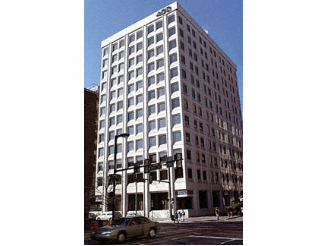Earlier this month, President Obama unveiled the Better Building Initiative (BBI), a public-private partnership that will invest $4 billion toward making federal and commercial office buildings more energy-efficient.
400 Market Street, an 11-story Philadelphia office tower built in 1972, is already serving as a model for how owners of hundreds of older, mid- and high-rise buildings throughout the Northeast and Midwest can reap the benefits of the program.
The 200,000 sf building, home to Philadelphia’s high-powered KWY-AM radio station, was recently renovated with a new HVAC system and a state-of-the-art window retrofitting system called RENOVATE by Berkowitz. According to energy modeling studies conducted with the U.S. Department of Energy’s most sophisticated energy modeling software, a typical 10- to 15-story office building like 400 Market Street could realize significant energy savings.
Developed by J.E. Berkowitz, a glass fabricator based in Pedricktown, N.J., the system works by converting existing single-pane windows into energy-saving, triple-glazed insulating glass units (IGUs) at a cost that is up to 50 percent less than ripping out and replacing old windows with new ones.
The window renovation system also has the benefit of being much faster and less disruptive to install. Berkowitz said the retrofit project for 400 Market Street took about 50 working days, which is two to three times faster than it would have been for a traditional “rip-out-and-replace” project for a similarly sized building. In addition, because the retrofitting was completed indoors, tenants were able to remain in their offices throughout the project. That is not possible with traditional window retrofitting solutions.
The BBI, which was first announced in January 2011, was developed to increase the energy efficiency in commercial buildings by 20 percent by 2020. Under the BBI, 60 private companies, municipal leaders and labor organizers have agreed on a plan to invest $2 billion of private capital to improve commercial, industrial, and manufacturing property. President Obama authorized the government to move forward with another $2 billion in energy-efficiency upgrades to federal buildings, which will be paid for by the long-term savings that the upgrades will provide. BD+C
Related Stories
Curtain Wall | Aug 15, 2024
7 steps to investigating curtain wall leaks
It is common for significant curtain wall leakage to involve multiple variables. Therefore, a comprehensive multi-faceted investigation is required to determine the origin of leakage, according to building enclosure consultants Richard Aeck and John A. Rudisill with Rimkus.
MFPRO+ News | Aug 14, 2024
Report outlines how Atlanta can collaborate with private sector to spur more housing construction
A report by an Urban Land Institute’s Advisory Services panel, commissioned by the city’s housing authority, Atlanta Housing (AH), offered ways the city could collaborate with developers to spur more housing construction.
Adaptive Reuse | Aug 14, 2024
KPF unveils design for repositioning of Norman Foster’s 8 Canada Square tower in London
8 Canada Square, a Norman Foster-designed office building that’s currently the global headquarters of HSBC Holdings, will have large sections of its façade removed to create landscaped terraces. The project, designed by KPF, will be the world’s largest transformation of an office tower into a sustainable mixed-use building.
Sustainability | Aug 14, 2024
World’s first TRUE Zero Waste for Construction-certified public project delivered in Calif.
The Contra Costa County Administration Building in Martinez, Calif., is the world’s first public project to achieve the zero-waste-focused TRUE Gold certification for construction. The TRUE Certification for Construction program, administered by Green Business Certification Inc. (GBCI), recognizes projects that achieve exceptional levels of waste reduction, reuse, and recycling.
Modular Building | Aug 13, 2024
Strategies for attainable housing design with modular construction
Urban, market-rate housing that lower-income workers can actually afford is one of our country’s biggest needs. For multifamily designers, this challenge presents several opportunities for creating housing that workers can afford on their salaries.
University Buildings | Aug 12, 2024
Planning for growing computer science programs
Driven by emerging AI developments and digital transformation in the business world, university computer science programs are projected to grow by nearly 15% by 2030.
Energy Efficiency | Aug 9, 2024
Artificial intelligence could help reduce energy consumption by as much as 40% by 2050
Artificial intelligence could help U.S. buildings to significantly reduce energy consumption and carbon emissions, according to a paper by researchers at the Lawrence Berkeley National Laboratory.
Sponsored | Healthcare Facilities | Aug 8, 2024
U.S. healthcare building sector trends and innovations for 2024-2025
As new medicines, treatment regimens, and clinical protocols radically alter the medical world, facilities and building environments in which they take form are similarly evolving rapidly. Innovations and trends related to products, materials, assemblies, and building systems for the U.S. healthcare building sector have opened new avenues for better care delivery. Discussions with leading healthcare architecture, engineering, and construction (AEC) firms and owners-operators offer insights into some of the most promising directions. This course is worth 1.0 AIA/HSW learning unit.
Office Buildings | Aug 8, 2024
6 design trends for the legal workplace
Law firms differ from many professional organizations in their need for private offices to meet confidentiality with clients and write and review legal documents in quiet, focused environments
Data Centers | Aug 8, 2024
Global edge data center market to cross $300 billion by 2026, says JLL
Technological megatrends, including IoT and generative AI, will require computing power to be closer to data generation and consumption, fueling growth of edge IT infrastructure, according to a new JLL report.

















